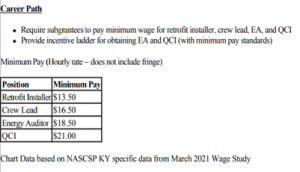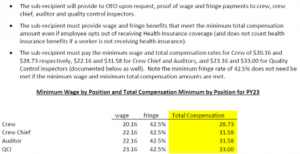In the fight against poverty, the Weatherization Assistance Program (WAP) plays a pivotal role in improving energy efficiency and transforming lives through its dedicated workforce. Behind every successful weatherization program is a team of skilled professionals making a difference. In this blog, we explore how minimum wages in WAP attract and retain top talent, empowering weatherization professionals to create a brighter future for themselves and those in need. Grantees like Kentucky and Vermont lead the way, recognizing their workforce’s importance by implementing minimum wage standards in their weatherization programs.
The Challenge: Building a Resilient Workforce
Weatherization programs nationwide grapple with the challenge of recruiting and retaining skilled professionals, who are essential for the success of these programs. A significant hurdle in this effort has been the issue of inadequate wages, which directly affects job satisfaction, employee turnover rates, and the overall quality of the weatherization services provided.
Kentucky recognized a wage gap when participating in the NASCSP WAP Wage Study. Conversations around minimum wages gained traction as the Grantee and subgrantees discussed the difficulties of recruiting and retaining crews due to the wage gap between WAP and other industries such as fast food and construction. Kentucky viewed this as an opportunity to align WAP wages with a broader job market, offering a competitive compensation package.
Meanwhile, Vermont faced a similar challenge with vacant or underpaid crew positions affecting agency performance. Collaborating with their subgrantees, Vermont conducted wage surveys that revealed struggling agencies were indeed offering lower wages. This eye-opening realization emphasized the need for implementing a WAP minimum wage, aiming to attract and retain skilled professionals and elevate the overall quality of weatherization services in the state.
The Solution: Implementing Fair and Competitive Compensation
Kentucky’s approach to addressing fair compensation for weatherization professionals involves a structured and transparent strategy. Collaborating with their subgrantees for input and feedback, the Kentucky WAP state plan sets clear minimum hourly wages for core roles within the Weatherization workforce. Using the NASCSP wage study and other workforce resources, Kentucky’s innovative approach included creating a career path with minimum pay standards that provide incentives for obtaining the energy auditor and quality control inspector certifications. For program year ’23, retrofit installers start at $13.50 per hour, with the opportunity to progress to crew leads, energy auditors, and Quality Control Inspectors, each with an increase in minimum pay.
The Kentucky subgrantee contract language mandates adherence to the state plan and ensures that all subgrantees are held accountable for providing fair compensation to their workforce. The structured career ladder, outlined in the Kentucky state plan and enforced through subgrantee contracts, incentivizes skill development and offers a clear path for professional growth.
In Vermont, approximately 85% of total weatherization program funds are from state funding, providing Vermont the opportunity to braid outside funds with DOE. This allows for a higher average cost per unit (ACPU) in their program and provides a unique opportunity to ensure the administrative costs do not burden the DOE WAP grant. To establish a standardized and fair wage structure, Vermont issued a weatherization program notice outlining the minimum wage requirements for the core roles within the weatherization workforce. The weatherization crew worker wage rates are updated annually to align with the state prevailing wage for insulation workers (floor, ceiling, wall). Additionally, when the wage rates are updated, subgrantees are required to use the highest prevailing wage for that position. For program year ‘23, crew workers in Vermont receive a minimum wage of $20.16 per hour, while crew chiefs and energy auditors earn two dollars per hour on top of that. Additionally, BPI-certified Quality Control Inspectors receive three dollars more per hour than the crew workers.
To ensure a comprehensive compensation package, Vermont also mandates a minimum of 42.5% in fringe benefits added to the wages to equal a total minimum compensation rate of $28.73 per hour. This fringe rate encompasses various benefits such as paid time off, retirement contributions, health insurance, and more, contributing to the overall well-being and job satisfaction of weatherization professionals. The sub-recipients are also required to provide proof of wage and fringe payments upon request, ensuring transparency and accountability in the implementation of these minimum wage standards. The Vermont Weatherization program notice also provides a frequently asked questions section to address potential questions and concerns.

The Impact: A Thriving Weatherization Workforce
The implementation of minimum wage requirements in these programs has had a great impact on both the workforce and the quality of services provided. The collaboration in Vermont and Kentucky highlights the importance of industry alignment and stakeholder buy-in. Vermont’s use of prevailing wages demonstrated the effectiveness of integrating state-specific data into wage adjustments, while Kentucky’s inclusion of incentives for core positions provided an extra layer of support to weatherization professionals.
In Vermont, two agencies that had previously struggled with staff recruitment and retention experienced a significant turnaround, illustrating the positive effects of fair compensation on workforce stability. Subgrantees have seen an expanded applicant pipeline with more qualified jobseekers and vacancies significantly improved, with a reduction of around 13-15%. Vermont subgrantees have also seen improvements in job satisfaction and employee motivation, ensuring that experienced staff remain within the program and continue to deliver high-quality services. This commitment to fair wages and comprehensive benefits has also resulted in an increase in the overall work quality and production.
Based on the fantastic feedback from their network, Kentucky’s approach has encouraged a culture of professional development and retention. By implementing these minimum wage requirements, Kentucky not only enhanced the well-being and job satisfaction of the weatherization workforce but also contributed to the cultivation of a skilled and motivated network. Competitive wages have facilitated the retention of experienced weatherization professionals, creating an environment where knowledge and skills are passed down to newer staff members. This has not only enhanced the professional growth of the entire network but also contributed to an increase in the program’s production numbers and work quality.
Looking to the Future: Supporting Weatherization Professionals
Vermont and Kentucky’s innovative approaches serve as excellent models for other states looking to implement minimum wage standards in their weatherization programs. By addressing the challenges head-on and crafting tailored solutions, these states have enhanced both the livelihoods of their weatherization professionals and the overall quality of their programs. Their success stories underscore the importance of valuing and investing in the workforce, laying down a blueprint for others to follow.
By providing fair and competitive compensation, we not only acknowledge the invaluable contributions of weatherization professionals but also lay the foundation for a stable, skilled, and motivated workforce. This, in turn, guarantees the continued success and impact of the Weatherization Assistance Program. The path to a brighter future for low-income households lies not only in the energy-saving measures we implement but also in the dedication and well-being of the professionals who make it all possible.
Have any questions? Are you interested in implementing minimum wage requirements in your state’s weatherization program? Don’t hesitate to reach out to Kye Garvin for additional guidance and support.
Interview Source:
- Keli Reynolds- Assistant Director, Single Family Development, Kentucky Housing Corporation
- Geoff Wilcox- WAP Director, Office of Economic Opportunity, State of Vermont





